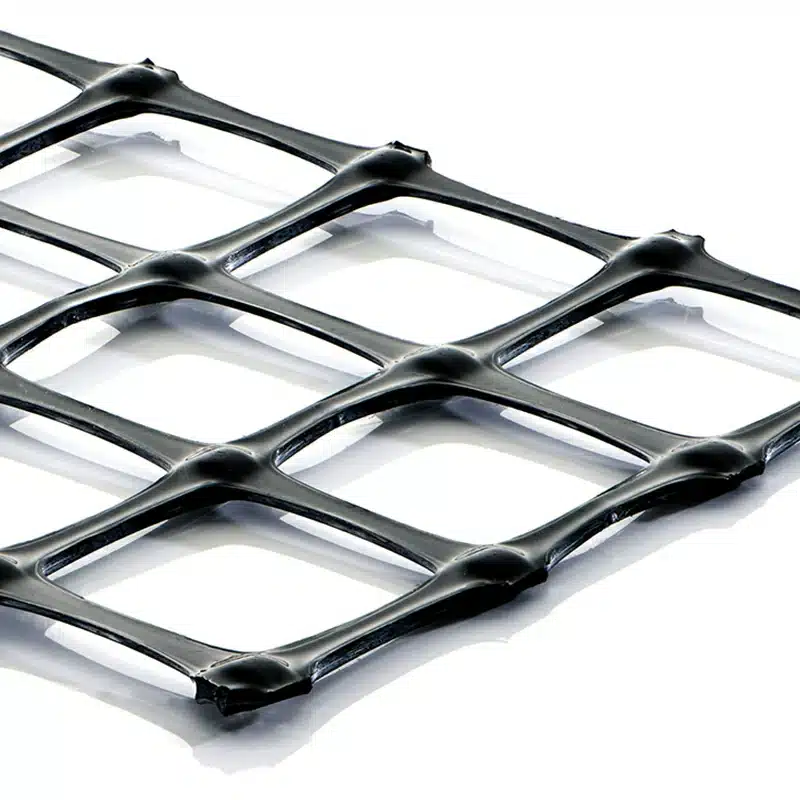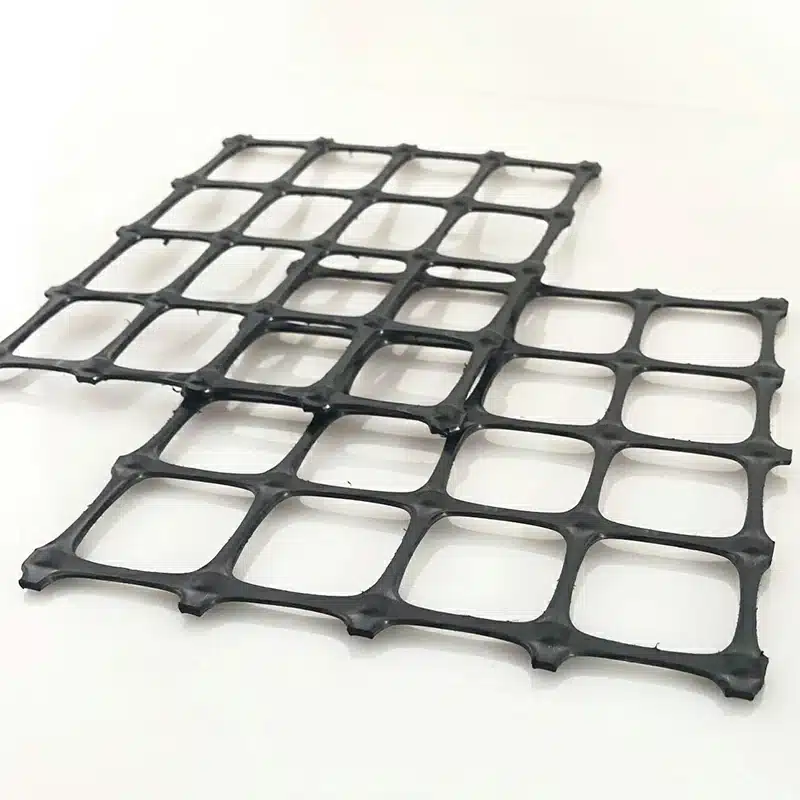+86-159 9860 6917
info@geofantex.com
geofantex@gmail.com
+86-400-8266163-44899
Retaining walls are essential structures in both civil and landscape applications, providing support to vertical slopes of soil and preventing erosion. One of the critical elements that enhance the stability and longevity of these walls is the use of geogrid fabric. But what makes the geogrid fabric so beneficial for retaining walls?

Understanding Geogrid Fabric
Understanding Geogrid Fabric
Composition
- Materials: Geogrid fabrics are typically made from polymers such as polyethylene, polypropylene, or polyester. They can also be made from fiberglass.
- Structure: The fabric consists of a grid-like structure with a regular pattern of apertures. This grid structure is crucial for its performance in reinforcing soils and other materials.
Function
- Soil Reinforcement: Geogrid fabric is primarily used to reinforce soil, improving its stability and load-bearing capacity.
- Load Distribution: It helps distribute loads more evenly across a wider area, reducing stress on underlying soils.
- Erosion Control: Geogrids can also help in controlling erosion by providing a stable structure that resists soil movement.
Applications
- Road Construction: Used in the base and sub-base layers to enhance pavement strength and longevity.
- Retaining Walls: Provides support and stability to retaining walls, reducing the risk of collapse.
- Embankments: Reinforces embankments and slopes, preventing landslides and soil erosion.
- Foundations: Utilized in foundation construction to improve load distribution and reduce settlement.
Benefits
- Increased Stability: Enhances the stability of soil and other materials, making structures safer.
- Cost-Effective: Can reduce construction costs by minimizing the need for additional materials and excavation.
- Longevity: Improves the lifespan of construction projects by preventing soil movement and erosion.
- Flexibility: Suitable for a variety of applications, from roads to retaining walls and embankments.
Limitations
- Installation: This requires careful installation to ensure effectiveness, which can be labor-intensive.
- Cost: Initial cost can be higher compared to traditional methods, though this is often offset by long-term savings.
- Environmental Factors: Performance can be affected by environmental conditions such as UV exposure and chemical degradation.
Key Benefits of Using Geogrid Fabric for Retaining Walls
- Enhanced Soil Stability: The interlocking patterns of the geogrid fabric help in trapping soil and gravel, preventing them from shifting. This results in a more stable and robust retaining wall structure.
- Flexibility in Wall Height: With products like the 3 Series suitable for wall applications up to 10 ft in height and the 5 Series for walls over 10 ft, geogrid fabric offers flexibility in constructing walls of various sizes.
- Durability: Made of high-strength polyester and coated with PVC plastic, geogrid fabrics are resistant to environmental elements, ensuring a longer lifespan for the retaining wall.
- Cost-Efficiency: Using geogrid fabric can save massive dollars in the long run by reducing the need for repairs and maintenance due to wall failures or soil erosion.
- Expert Recommendation: Many professionals and experts in the field of civil engineering and landscaping recommend the use of geogrid fabric for retaining walls, given its proven benefits and effectiveness.

Why is regular maintenance essential for geonet water flow optimization?
Regular maintenance of geonet systems is essential for several reasons that ensure optimal water flow. Here is a detailed explanation:
Prevents Blockages:
- Debris Accumulation: Over time, debris such as leaves, soil, and other particles can accumulate within the geonet system, leading to blockages. Regular cleaning prevents these obstructions, ensuring smooth water flow.
- Sediment Build-up: Sediment can settle in the geonet layers, reducing permeability. Routine maintenance helps to remove these sediments.
Maintains Structural Integrity:
- Wear and Tear: Geonet materials can degrade due to environmental factors such as UV exposure, chemical reactions, or physical damage. Regular inspections can identify and rectify any damage before it compromises the system.
- Erosion Control: Consistent maintenance helps in monitoring and managing erosion, which can affect the stability and effectiveness of the geonet.
Ensures Consistent Performance:
- Optimal Functionality: Regular maintenance ensures that the geonet system functions at its designed capacity, providing consistent water flow and drainage.
- Performance Monitoring: Scheduled maintenance allows for performance assessments, ensuring the system meets required standards and specifications.
Cost-Effectiveness:
- Preventive Measures: Addressing minor issues during routine maintenance can prevent major failures, reducing long-term repair costs.
- Extended Lifespan: Proper care and maintenance can extend the lifespan of the geonet system, providing a better return on investment.
Environmental Protection:
- Pollution Prevention: Maintaining the geonet system reduces the risk of pollutants entering the water flow, protecting surrounding ecosystems.
- Sustainable Water Management: Effective water flow management through well-maintained geonet systems supports sustainable water use and conservation.
FAQs on Geogrid Fabric for Retaining Walls
What is the geogrid fabric?
Geogrid fabric is a type of geosynthetic material used to reinforce soil and similar materials. It is commonly used in construction, particularly for retaining walls, to provide structural support and stability.
How does geogrid fabric work in retaining walls?
Geogrid fabric works by interlocking with the fill material, creating a stable mass that can withstand lateral earth pressures. The grid pattern allows for the soil to pass through and interlock, enhancing the overall stability and strength of the retaining wall.
What are the benefits of using geogrid fabric in retaining walls?
- Increased Stability: It enhances the structural integrity of retaining walls.
- Cost-Effective: Reduces the need for additional materials and labor.
- Durability: Provides long-term stability and resistance to environmental factors.
- Versatility: Suitable for various soil types and construction applications.
What types of geogrid fabrics are available?
- Uniaxial Geogrids: Designed to handle stress in one direction, ideal for wall reinforcement.
- Biaxial Geogrids: Can handle stress in two directions, suitable for ground stabilization and retaining walls.
- Triaxial Geogrids: Offer multidirectional reinforcement, providing high load-bearing capacity.
How is geogrid fabric installed in retaining walls?
- Site Preparation: Clear and level the area where the retaining wall will be built.
- Base Layer: Lay the first layer of geogrid fabric over the base material.
- Layering: Add fill material over the geogrid, compact it, and repeat the process with additional geogrid layers as needed.
- Final Touch: Finish with the top layer of fill material and complete the retaining wall construction.
What factors should be considered when choosing geogrid fabric?
- Load Requirements: Determine the load-bearing capacity needed.
- Soil Type: Select a geogrid compatible with the specific soil conditions.
- Project Specifications: Consider the design and dimensions of the retaining wall.
- Environmental Conditions: Choose a geogrid that can withstand local weather and environmental factors.
Can geogrid fabric be used for other applications?
Yes, geogrid fabric is versatile and can be used for various applications including road construction, embankment stabilization, erosion control, and more.
In conclusion, the use of geogrid fabric in retaining walls is not just a trend but a necessity. It ensures that the walls are sturdy, durable, and can withstand the test of time and environmental elements.



Get Free Sample
We’ll respond as soon as possible(within 12 hours)






















